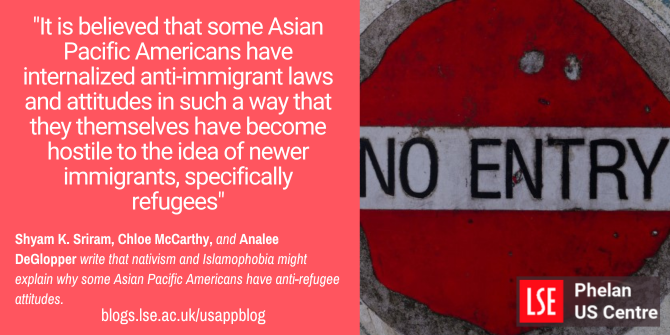

 In his bid for the presidency in 2016 and throughout his White House term, Donald Trump used racist rhetoric against Muslims and minorities to play up feelings of nativism among Americans. Shyam K. Sriram, Chloe McCarthy, and Analee DeGlopper write that these nativist sentiments were not confined to Americans of European descent: surveys ahead of the 2016 election found that significant numbers of Asian Americans were opposed to the resettlement of Syrian refugees and in favor of a ban on Muslim immigrants. They argue that these attitudes are driven by perceptions of Syrians not as refugees, but as Muslims, and that Asian American immigrant groups are often primed to be Islamophobic before they even come to the US.
In his bid for the presidency in 2016 and throughout his White House term, Donald Trump used racist rhetoric against Muslims and minorities to play up feelings of nativism among Americans. Shyam K. Sriram, Chloe McCarthy, and Analee DeGlopper write that these nativist sentiments were not confined to Americans of European descent: surveys ahead of the 2016 election found that significant numbers of Asian Americans were opposed to the resettlement of Syrian refugees and in favor of a ban on Muslim immigrants. They argue that these attitudes are driven by perceptions of Syrians not as refugees, but as Muslims, and that Asian American immigrant groups are often primed to be Islamophobic before they even come to the US.
The Syrian Civil War, which began in 2011, catapulted the fate of displaced Syrians to the top of global human rights concerns. During their tenures, Presidents Trump and Obama offered alternative visions of the refugee resettlement and admissions program. Public opinion similarly, was polarized, with some studies showing support while other polls show a reluctance to accept Syrian refugees. Gallup polling noted that the 2015 Paris attacks increased political interest on refugees in the United States, exacerbated by 26 governors stating their opposition to resettlement of Syrians in their states.
Lost in this has been a more nuanced discussion of one group of Americans and their attitudes towards Syrian refugees: Asian Pacific Americans. According to the Pew Research Center, Asian Pacific Americans are the fastest growing minority in with a 72-percent increase in population from 2000 to 2015, and with over 22 million now living in the US. Recent analysis has also shown that Asian Pacific Americans had the largest spike in voter turnout between 2016 and 2020, partly motivated by President Trump’s rhetoric, and by decades-long work by organizers and activists in the community. While Vice President Kamala Harris’s identity, former South Carolina Governor, Nikki Haley’s current presidential aspirations and those previously of Andrew Yang have improved public perceptions, most people still reduce this diverse community to a singular racial block simply known as “Asian.”
Examining ‘nativism’ in America
Drawing the two areas of focus together, we examined Asian Pacific American support for the resettlement of Syrian refugees in the United States using the 2016 National Asian American Pre-Election Survey (NAAS). It was administered before that year’s election and provides a tremendous amount of insight into the political attitudes of a wide array of Asian Pacific Americans from nine unique heritage identities: Native Hawaiian, Indian (South Asia), Cambodian, Chinese, Filipino, Hmong, Japanese, Korean, and Vietnamese. The sample included nearly 4,800 respondents.

Photo by Matt Seymour on Unsplash
Anti-immigrant rhetoric and hysteria have been present throughout the history of this nation and often take the form of moral panics. President Trump’s rhetoric and policies were often labelled xenophobic, nationalist, and Islamophobic. One phrase, however, slowly began to dominate the conversation – nativist, meaning privileging the interests of native-born Americans over those of immigrants. The concept that not all immigrants are seen as positive and capable of good contributions, and that some immigrants are preferred over others, is not new. But what made the case of Trump-era nativism so profound was that it uncovered deep wounds in the American mythos of inclusion and democracy as nativism was leaned on to develop anti-Asian hysteria around COVID-19.
Support for Syrian refugee resettlement and the ‘Muslim ban’
In a prescient research design, the survey investigators asked two policy-related questions months before they became public law with President Trump’s early executive orders: support or opposition to the resettlement of Syrian refugees and a ban on Muslim immigrants coming to the United States. The NAAS investigators noted that 62 percent of the study’s Asian American registered voters opposed banning Muslim immigrants, as well as reporting that differences existed among communities. They also make a similar argument about the question about allowing Syrian refugees in the United States.
Of the 14 Asian heritage communities, only the Hmong, Indian, Japanese, Korean, and Tongan NAAS respondents said they were more likely to support Syrian refugees than be opposed to their resettlement. As a point of contrast, the remaining nine communities – Cambodian, Chinese, Filipino, Fijian, Laotian, Native Hawaiian, Samoan, Taiwanese, and Vietnamese – were all more likely to oppose Syrian refugee resettlement. These are startling findings for a pool of Americans whose families were affected by refugee crises more than other immigrants.
Is opposition to Syrian refugee resettlement an adequate stand-in for opposition to Muslims? Not necessarily, but the dataset allowed the relationship between Islamophobia (in terms of support for an anti-Muslim immigrant ban) and opposition to Syrian refugees in the United States to be tested. Respondents who identified as Republican were just over three times more likely than those who identified as Democrats to oppose Syrian refugees coming to the United States. Second, respondents holding Islamophobic views were just under two and a half times more likely than those holding pro-Muslim views to oppose Syrian resettlement.
The results of our analysis for each of the nine Asian Pacific American communities are fascinating and complex. The first observation is that support for a ban on Muslim immigrants, which we used to measure Islamophobia, predicted anti-refugee acceptance for all nine communities. However, of the nine communities, Islamophobia was only statistically significant for Americans of Indian, Japanese, Vietnamese, Hmong, and Korean descent. The inclusion of a partisanship variable, specifically to look at the effects of respondents’ self-defined Republican affiliation, also mostly predicted support for an anti-Syrian refugee attitude; However, both variables were only significant for respondents from two unique heritage communities – Japanese and Indian.
Perceptions of refugees affects support among Americans of Asian descent.
The NAAS data reveals that Americans of Asian descent are not as supportive of Syrian refugees as one might expect. This barrier to acceptance is not only a failure of traditional models ascribing a condition of linked fate or shared experiences amongst all refugees or immigrants, but is one largely affected by perceptions of Syrians not as refugees, but as Muslims. Anti-immigrant, nativist views within this community are the product of US domestic and foreign policy towards Asian Pacific Americans. We believe this is a question of socialization or transnationalism. Asian immigrants develop Islamophobic attitudes in the countries they come from and are socialized into these transnational environments through a hostile form of internalized political socialization. It is not about “learning” to be Islamophobic in the United States; we believe that Asian Pacific Americans are primed to do so. The UN’s Office of High Commissioner for Human Rights and Genocide Watch have documented as such in Burma, China, and India. Recent research also points to the rise of Islamophobia in Japan; South Korea; Sri Lanka; and Thailand and the Philippines.
While 9/11 influences 21st-century Islamophobia, the Syrian Civil War along with Trump’s anti-immigration policy alongside an anti-Islam stance has further increased an illogical fear of Islam in the US. This fear has extended to Asian Americans, as highlighted by the 2016 NAAS data, resulting in Asian Pacific Americans becoming “new nativist publics.” These are minorities that were not previously thought to be capable of nativism but have since somewhat adopted the nativist attitudes of Americans of European descent. By this logic, it is believed that some Asian Pacific Americans have internalized anti-immigrant laws and attitudes in such a way that they themselves have become hostile to the idea of newer immigrants, specifically refugees, entering the United States.
Will anti-refugee sentiment continue?
If the National Asian American Pre-Election Survey was conducted in the coming years, would Asian Americans respond differently, and would the results reflect the election of Joe Biden and be more likely to favour Syrian refugees? If Biden adopts a more accommodating policy towards refugees, will the United States experience a continuation of Islamophobic and anti-refugee sentiment at a societal level?
A special issue of the Amerasia Journal recently focused on the rise of “Conservatisms and Fascisms in Asian America” with a major emphasis on religion. Adrian De Leon and Jane Hong argue that Asian American conservatism is not merely an aspect or idea that was brought to the United States. Instead, it is a structural formation that aids in creating, establishing, and producing the community of Asian Americans. In the same issue, Yucheng Bai focused on the role of religion among Chinese Americans, suggesting that many Chinese American Christians self-identified with aspects of the Republican Party and supported Trump despite his anti-immigrant rhetoric, voting for him in both the 2016 and 2020 elections. This group supported certain Republican policy positions including opposition to abortion, same-sex marriage, and welfare. Chinese American Christians are often politicized through their churches.
Anti-refugee attitudes are not simply a more relevant extension of classical debates on immigration, acceptance, and belonging. Just as nativism was linked to anti-Chinese, German, and Catholic attitudes in the 19th century, the pairing over the last few years has been the conflation of nativist attitudes with Islamophobic ones.
- Please read our comments policy before commenting.
- Note: This article gives the views of the author, and not the position of USAPP – American Politics and Policy, nor the London School of Economics.
- Shortened URL for this post: https://bit.ly/3Ya5AT2






